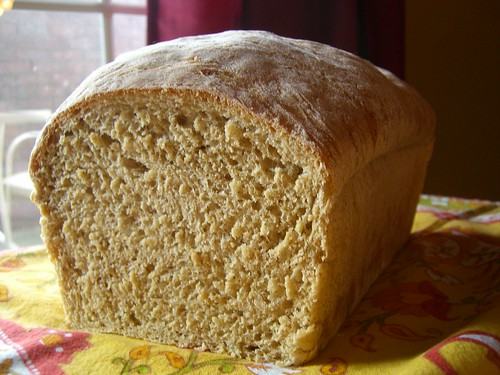Today begins the first day of my last year of seminary, and as expected, I'm getting a wee bit nostalgic. Even though I've only had two years of schooling, it's kind of amazing to think of all the things I've learned and how I've changed in those two years. Things that were abnormal or scary two years ago are now commonplace. Two years ago, I couldn't have talked about the Donatist Controversy or the Gnostics or anything theological, but now those conversations take place over lunch. It reminds me of when I was learning to drive a manual transmission car. At first, I over-thought the whole process and ended up stalling out. Once I figured out how to go with the flow, it was second nature.
Another thing I couldn't do two years ago? Bake my own bread. I was terrified of yeast and sticky dough that got on everything. Now, I stumble upon a recipe like this one from Orangette and think, "Maybe I'll make that this weekend." And since school is now in session, many sandwiches will be schlepped to school and eaten. I made one loaf as a housewarming present for a friend and another loaf for Joe to eat since I'm traveling to Texas on Wednesday for my ordination candidacy interviews with my diocese.
This bread has a nice dense, even crumb, and I love the addition of oatmeal which adds a touch of sweetness. I also found the dough very easy to work with. I might add the step of letting the dry ingredients soak in the moisture for about thirty minutes because it really seemed to add a silkiness to the dough. It may not be "the bread of life" but it's pretty darn good sandwich bread.
What have you learned to do that was difficult at first but is now second nature?
What have you learned to do that was difficult at first but is now second nature?
Oatmeal Sandwich Bread
adapted slightly from Orangette
Ingredients
3 Tbsp. dark corn syrup
2 ½ cups white whole wheat flour
2 cups all-purpose flour
1 cup rolled oats
4 Tbsp. unsalted butter, melted and cooled slightly
2 ¼ tsp. table salt, or to taste
Preparation
Grease a large bowl and a 9X5X3 loaf pan with butter or cooking spray.
In a large bowl, combine 2 cups warm water, the yeast, and corn syrup. Stir briefly, and then allow the yeast to bloom for about 5 minutes. Add the flours, oats, and butter, and stir to mix. The dough will look rough and shaggy. Cover with a towel, and let stand for 30 minutes. [This rest allows the dry ingredients to absorb the liquids, making for a dough that’s easy to work with and even-crumbed.]
Add the salt, and knead by hand for about 15 minutes, adding flour as needed. The dough should be soft and supple and slightly sticky.
For the first rise, put the dough into the greased bowl, cover with a towel, and leave it to rise for about 1 hour, or until it is doubled in size. To see if it’s ready, gently push a floured finger into it. If the dough springs back, it needs more time; if the dimple remains, it’s ready for the next step.
To shape the dough, scrape it onto a floured work surface. Press down on it, working it into a square shape, taking care to depress any bubbles. Fold the dough down from the top to the middle, then up from the bottom to the middle. Next, bring the newly formed top and bottom edges together, pinching the seam to seal. Pinch the sides together, and roll the shaped dough back and forth, plumping it so that it’s evenly formed and about the size of your pan. Place the dough in the pan with the seam side down, and press it gently into the corners of the pan.
For the second rise, cover the dough with a towel, and let it rest in a warm place for about 1 hour, or until the dough rises to half again its size. While the dough is rising, preheat the oven to 400°F.
When the dough has finished its second rise, bake for about 40 minutes, rotating the pan halfway through. The loaf is ready when the top crust and bottom crusts are nicely browned. To see if the bread is ready, give the top of the loaf a thump with your hand. If it sounds hollow, it’s ready; if not, give it another few minutes in the oven. Remove the finished loaf from the pan and cool completely on a wire rack. Resist the urge to cut in until it’s fully cooled, so that the crumb has time to set and the flavor can develop.
Yield: 1 loaf


